This was published 6 years ago
Cruising the Mekong Thailand to Laos: Cruise through a land of untouched rugged beauty
By Mike O'Connor
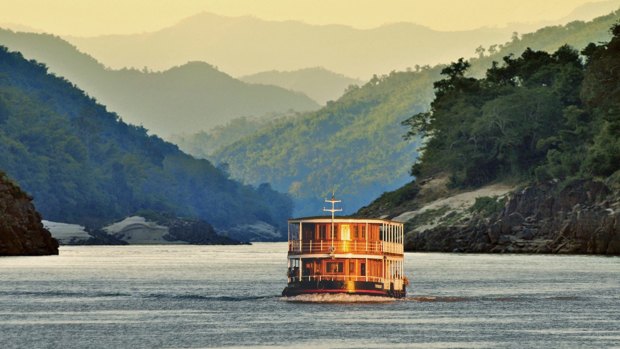
The journey aboard the Laos Pandaw is about the Mekong River and its constantly changing character.
We hit the sandbank mid-afternoon, a shudder rippling through the hull, signalling an unscheduled halt to the down river progress of the Laos Pandaw. We sit in the middle of the Mekong River surrounded by the lush green of the Laotian jungle for the next 24 hours, an object of curiosity to passing fishermen.
The cavalry finally arrives in the form of four rice barges that, in an oily smokescreen of bellowing diesel exhaust, push, pull and nudge us free.
Such are the hazards of navigating the Mekong in the dry season as it alternately meanders and rushes from Tibet through China, Thailand, Laos, Myanmar, Cambodia and Vietnam on its way to its sprawling delta in the South China Sea.
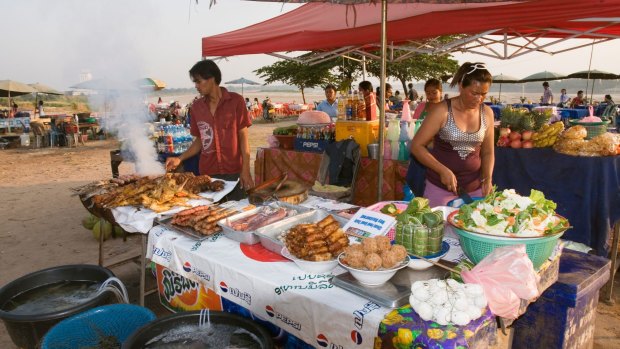
Food stalls on side of Mekong River, Vientiane, Laos.Credit: Alamy
Our Laos Pandaw journey begins in Thailand at Chiang Saen about five hours by bus from Chiang Mai. Ahead lie 10 nights of river cruising through Laos with three nights spent moored at Luang Prabang and one night at our final destination of Vientiane, the capital of Laos.
It's a relatively small ship of two decks with only 10 cabins on the lower and a spacious enclosed saloon and open-sided dining and lounging area on the upper level. We are two of 14 passengers on the cruise, all seeking an experience removed from the more travelled track.
We encounter the sandbank on day two and on day three resume the itinerary with a stop at Huay Xai. The river front town's main claim is to be a departure point for those catching a slow boat downstream to Luang Prabang, many of whom have crossed from Thailand over the Thai-Lao Friendship Bridge 10 kilometres from the town.
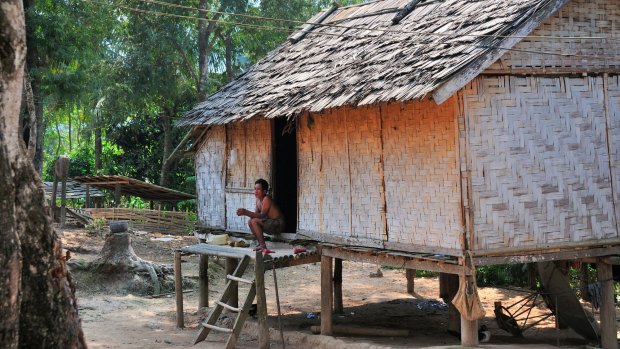
Traditional Hmong village house on stilts on the banks of The Mekong River, Northern Laos.Credit: Alamy
We climb several hundred steps to a wat that gives a sweeping view of the Mekong and on the way back to the ship are stopped by Lao police looking for smugglers from China. We're left wondering just how many Chinese smugglers disguise themselves as camera-toting western tourists in floppy hats with sunburnt noses.
Mid-morning we visit Ban Dan village, a settlement of Lao Lowland people where the adults smile shyly and the children shriek and play. Their lives are basic, the dirt-floored huts at odds with the television satellite dishes in which red chilies have been laid out to dry.
The journey, however, is about the river and its constantly changing character. At times it is broad and sluggish with its flood plain sprouting neatly fenced market gardens. Then suddenly it narrows into a maelstrom of whirlpools and eddies.
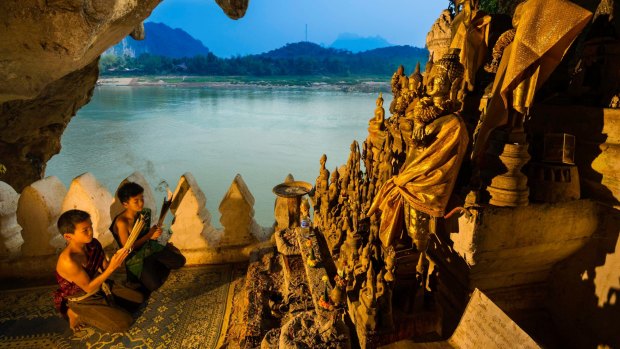
Pak Ou caves with 2500 buddha statues in Luang Prabang province, Laos.Credit: Alamy
Early in the voyage I find the best place on the ship to stretch out and relax and take up station in a deckchair in the bow. From there I watch as time after time, Pandaw Laos heads towards seemingly impassable barriers of jagged rocks and white water.
When disaster seems imminent, a channel opens and with the river slapping against the hull and the engine note rising, we dive through the rapids.
The countryside is as diverse as the river itself, the jungle closing to the river's edge before retreating to reveal more flood lands. The mountains are ever present, sometimes distant and blue-tinged and at other times advancing to form canyons through which the suddenly diminutive 45-metre Laos Pandaw glides.
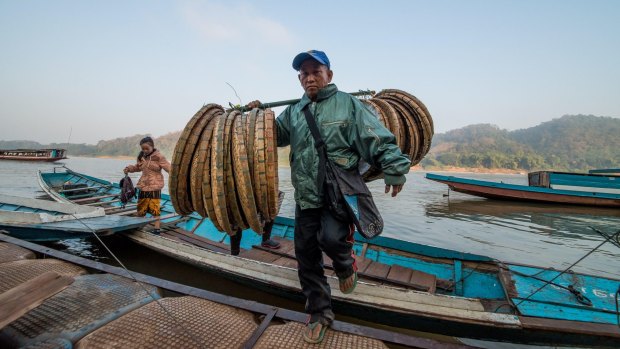
A street vendor carrying his goods on the Mekong riverside in Luang Prabang.Credit: Alamy
As on all cruises, a rhythm is quickly established. Shipboard life begins with coffee and pastries on deck at 6am when the river is still shrouded in mist and the air temperature chills. Breakfast is from 7am until 10am after which there is a drift towards the deckchairs, books clutched underarm, the sun sparkling off the river as the temperature rises.
Occasionally the long, narrow-hulled passenger boats that ply between Chiang Saen, Luang Prabang and Vientiane overtake our stately progress, their grinning passengers, mainly Thais and Laotians, waving as they leave us in their wake.
Cocktails are at 6pm, dinner at 7pm and by 10pm the deck is deserted. Those seeking a party boat should look elsewhere.
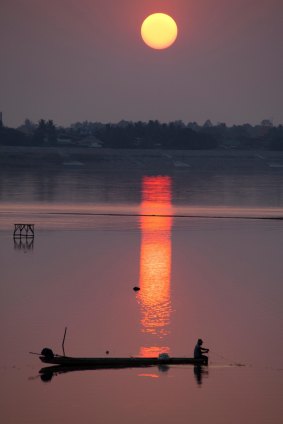
The Mekong's course through Laos takes the traveller through a land of mostly untouched rugged beauty.Credit: Alamy
I rise early on day five to find the river shrouded in a grey blanket, visibility reduced to less than 10 metres.
It's a cold, damp mist that delays our departure and creates an eerie sense of isolation, the mountains and jungle for once invisible. By 11am it has cleared and we resume our journey, pausing to visit the Buddha Caves at Pak Ou and late that afternoon moor at Luang Prabang.
The UNESCO World Heritage-listed city retains many architectural vestiges of its French colonial past with wooden window shutters and the chocolate brown of aged timber contrasting with the shocks of pink and mauve bougainvillea that drape the sidewalks.
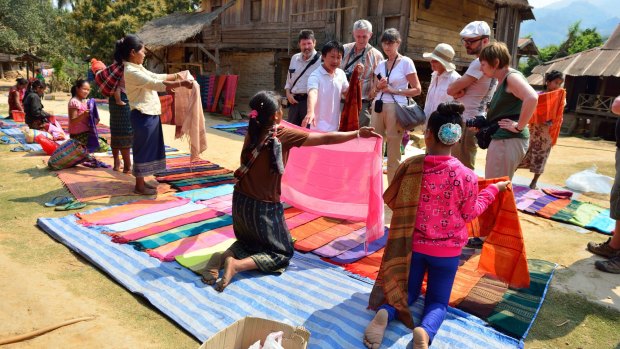
Hmong tribe villagers showing their sewing craft to tourists to buy on route along the Mekong River banks.Credit: Alamy
We leave our fellows passengers that night and head ashore to dine at L'Elephant where an excellent five-course meal for two and a bottle of French red costs us just $60.
The alms offerings to the hundreds of Buddhist monks who file through the city pre-dawn are a well-established tradition for visitors to Luang Prabang. The ship provides a basket of offerings for each guest, mainly sweets and biscuits, the still dark main street lit by a myriad of camera and smartphone flashes as the monks, some impossibly young, move in a saffron-robed procession through the city.
It's a great walking city bracketed by the Khan and Mekong rivers and later in the day, in search of more secular pastimes, we follow a serpentine path that leads us to Utopia.
It's a bar, or more properly an open-air space on the banks of the Khan River laid out with lounges and tables where backpackers drink cheap beer, lay about and enjoy the delight of having nothing to do and an abundance of like-minded people with whom to do it. I offer the observation that I'm the oldest person in the bar by at least 20 years. "Make that 30," says my wife.
There are markets and riverside restaurants and a general air of tranquility. For those wanting to excuse themselves from the world for a week, Luang Prabang beckons.
Over the next few days of cruising we visit the Hmong village of Ban Na Sarn where 22 families live in dirt-floored huts on the edge of a teak forest.
I watch as a man makes arrows for a crossbow. "What will he hunt?" I ask our guide. "Rats," he replies.
Later that day we pass through the lock that forms part of the Xayaburi Dam, the Laos Pandaw dropping about 30 metres before exiting and continuing downstream.
We arrive in Vientiane as scheduled on day 10, take a temple-focused bus tour of the city and the next morning, farewell the ship and our fellows.
The Mekong's course through Laos takes the traveller through a land of mostly untouched rugged beauty.
With more dams planned, you cannot but wonder for how long such journeys will be possible.
TRIP NOTES
MORE
FLY
Thai Airways and Qantas operate flights to Chiang Mai and Chiang Rai via Bangkok. Pandaw Cruises transfers passengers from hotels in both cities to the embarkation point at Chiang Saen.
CRUISE
Pandaw Cruises operates 10-night cruises downstream and upstream between Chiang Saen in Thailand and Vientiane, Laos from $US3780 ($4930) per person twin share. See pandaw.com
STAY
The colonial – circa 1932 – and conveniently located Settha Palace hotel in Vientiane at 6 Pang Khan Street has deluxe rooms from $275 per night. Don't leave without dining at Pimenton at 5, Rue Nokeoukoumane, Vientiane.
Mike O'Connor was a guest of Pandaw Cruises.
Sign up for the Traveller Deals newsletter
Get exclusive travel deals delivered straight to your inbox. Sign up now.